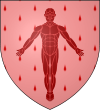House Liddle
| House Liddle | |
|---|---|
 | |
| Coat of arms |
Per pale white and green, a fir tree line between, three brown pinecones on the white (Per pale sapiné argent and vert, in dexter three pinecones brunâtre) |
| Seat | In the northern mountains |
| Head | Lord Torren Liddle[1] |
| Region | North |
| Titles | |
| Heir | Morgan Liddle[2] |
| Overlords |
|
House Liddle is the formal name given to the Liddles, one of the northern mountain clans in the north. They inhabit the high mountains north of the wolfswood.[3] The chief of the clan is known as "The Liddle", although at Winterfell he is given the treatment of "Lord Liddle".
Their arms are per pale white and green, a fir tree line between, three brown pinecones on the white.[4] Their motto does not appear in the books.
Contents
Recent Events
A Storm of Swords
Bran Stark recalls there are some Liddles living in the high places during his journey to the Wall with Hodor, Meera, and Jojen Reed. They meet a man from the mountain clans whom Bran identifies as a Liddle because of the pinecone-shaped gold and bronze clasp fastening his cloak. The Liddle shares oatcakes, blood sausage, and ale, without asking their names nor giving his.[3]
Maester Aemon sends ravens to most of the noble houses from the north asking for help to fight the wildlings at Castle Black, including the Liddles.[5]
A Dance with Dragons
Morgan Liddle joins the army of King Stannis Baratheon and participates in the fight by Deepwood Motte.[6] He later apologizes to Asha Greyjoy for cursing at her during the battle.[7]
House Liddle at the end of the third century
The known Liddles during the timespan of the events described in A Song of Ice and Fire are:
- Lord Torren Liddle, known as the Liddle, the head of the clan.
- Duncan Liddle, known as Big Liddle, his eldest son, a ranger of the Night's Watch.
- Morgan Liddle, known as Middle Liddle, his second son.
- Rickard Liddle, known as Little Liddle, his third son.
- The Liddle, a traveler met by Bran Stark in the northern mountains.
Quotes
One day there would be Starks in Winterfell again, he told himself, and then he'd send for the Liddles and pay them back a hundredfold for every nut and berry.[3]
—thoughts of Bran Stark
Behind the Scenes
Big Liddle, Middle Liddle, and Little Liddle are probably references by George R. R. Martin to Liddell & Scott, a standard lexicographic work of Ancient Greek, which was published in three sizes called "The Big Liddell", "The Middle Liddell" and "The Little Liddell".
References
- ↑ 1.0 1.1 A Feast for Crows, Appendix.
- ↑ 2.0 2.1 A Dance with Dragons, Appendix.
- ↑ 3.0 3.1 3.2 A Storm of Swords, Chapter 24, Bran II.
- ↑ The Citadel. Heraldry: the North
- ↑ A Storm of Swords, Chapter 55, Jon VII.
- ↑ A Dance with Dragons, Chapter 26, The Wayward Bride.
- ↑ A Dance with Dragons, Chapter 42, The King's Prize.
| ||||||||||||||||||||||||||||||||||||||||||||||||||||||||||||||||||||||||||||||||||

